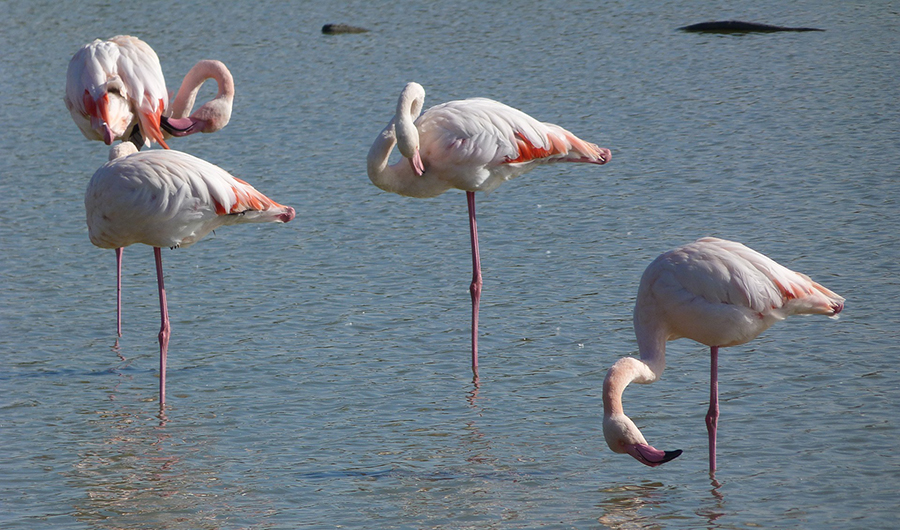How Flamingos Stand on One Leg
(Inside Science) – Flamingos are iconic. As the pink birds congregate in ankle-deep water, they stand tall, each atop a single, spindly leg.
Many ideas have tried to explain this one-legged stance. Maybe the position prevents muscle fatigue. Or, perhaps it minimizes heat loss. Now a new study suggests another reason: It saves energy.
"It's actually likely to be easier to stand on one leg than two legs," said Young-Hui Chang, a comparative neuromechanist at the Georgia Institute of Technology in Atlanta.
Using two cadaver flamingos, Chang and Lena Ting, a comparative neuromechanist at Emory University in Atlanta, found that the bird could settle into a stable, one-legged position. "They fold down," Ting said. "The interaction of the different joints and ligaments are such that you can push down on it and it doesn't move. But if you pull up on the body, it unfolds very easily."
The dead bird is obviously not flexing any of its muscles -- yet its legs naturally settle into a pose resembling the one-legged posture seen in the wild. What prevents the flamingo from falling to the ground is a mechanism akin to how a doorstop holds a door open.
"These guys have a kind of hip-stop and a knee-stop, which is pretty cool," said Rodger Kram, a physiologist at the University of Colorado in Boulder.
Live flamingos, then, must not use much energy at all to maintain a one-legged stance. Researchers have previously suggested flamingos alternate standing on each leg to prevent their muscles from tiring, similar to how you shift your weight from one leg to the other while waiting in a long line. But if the birds don't use any muscles in the first place, this hypothesis is unlikely, the researchers said.
The analysis, published today in the Royal Society journal Biological Letters, is quite convincing, Kram said. "The cadaver [experiment], to me, is pretty much a slam dunk."
In a second set of experiments, the researchers measured how much eight live, juvenile flamingos swayed while standing on one leg in the lab. Awake and alert birds swayed in their stance more than those that were resting or sleeping -- the opposite of what a human would do. If flamingos are more stable while asleep, then that's further evidence the birds passively relax into the posture.
On a practical level, Chang said, understanding how flamingos stand with minimal effort could help engineers design robotic legs, prosthetic devices and exoskeletons.
"This paper is an important one," said Matthew Anderson, a comparative psychologist at Saint Joseph's University in Philadelphia. "It makes a very significant contribution in at least giving us some evidence for how flamingos engage in this characteristic behavior."
Indeed, according to both Anderson and the researchers, the conclusions are more an explanation for how flamingos maintain their posture than for why. To understand the latter, Anderson said, you have to observe the birds in the wild.
His own research suggests that by tucking one leg away, a flamingo minimizes its exposure to cold air and especially water. A previous study found that more flamingos stand on one leg when the temperature is cooler. The one-legged position also occurs more frequently in water than on land. Both pieces of evidence point strongly toward staying warm as one of the main reasons for the one-legged stance, he said.
But conserving energy could be a secondary reason, and one that complements the heat-loss hypothesis. If a flamingo had to expend more energy to stand on one leg, doing so would just create more heat that would get lost, Chang said.
The analysis might even apply to other birds, many of which also stand on one leg. Still, one-legged stances in other species don't quite compare to the extreme posture of the pink, leggy birds. "Flamingos," Chang said, "epitomize the behavior."


